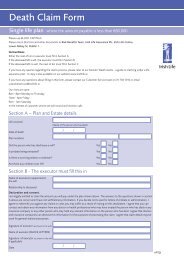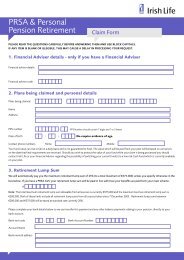Mortgage Protection booklet - Irish Life
Mortgage Protection booklet - Irish Life
Mortgage Protection booklet - Irish Life
You also want an ePaper? Increase the reach of your titles
YUMPU automatically turns print PDFs into web optimized ePapers that Google loves.
You can claim if you suffer cardiomyopathy which is permanent and<br />
causing symptoms which significantly hinder your normal everyday<br />
activities. To qualify for payment your physical ability must be<br />
measurable and limited to a specific degree (New York Heart Association<br />
Class 3). The NYHA Function Classification is a measure used to classify<br />
the extent of heart failure.<br />
11. Coma – of specific duration and resulting<br />
in permanent symptoms<br />
Plan definition:<br />
A state of unconsciousness with no reaction to external stimuli or internal<br />
needs which:<br />
• Continues for a period of at least 96 hours.<br />
• Requires life supporting systems including assisted ventilation<br />
throughout the period of unconsciousness.<br />
• Results in permanent neurological deficit with persisting clinical<br />
symptoms*.<br />
For the above definition, the following is not covered:<br />
• Coma secondary to alcohol where there is a history of alcohol abuse.<br />
• Coma secondary to illegal drug abuse.<br />
33<br />
*”permanent neurological deficit with persisting clinical symptoms” is<br />
clearly defined as:<br />
Symptoms of dysfunction in the nervous system that are present<br />
on clinical examination and expected to last throughout the insured<br />
person’s life.<br />
Symptoms that are covered include numbness, hyperaesthesia<br />
(increased sensitivity), paralysis, localised weakness, dysarthria (difficulty<br />
with speech), aphasia (inability to speak), dysphagia (difficulty in<br />
swallowing), visual impairment, difficulty in walking, lack of coordination,<br />
tremor, seizures, dementia, delirium and coma.<br />
The following are not covered:-<br />
• An abnormality seen on brain or other scans without definite related<br />
clinical symptoms.<br />
• Neurological signs occurring without symptomatic abnormality, e.g.<br />
brisk reflexes without other symptoms.<br />
• Symptoms of psychological or psychiatric origin.<br />
In Simpler terms:<br />
A coma is a state where a person is unconscious and cannot be brought<br />
round. Someone in a coma will have little or no response to any form of<br />
physical stimulation and will not have control of their bodily functions<br />
Comas are caused by brain damage, most commonly arising from a head<br />
injury, a stroke or lack of oxygen.

















